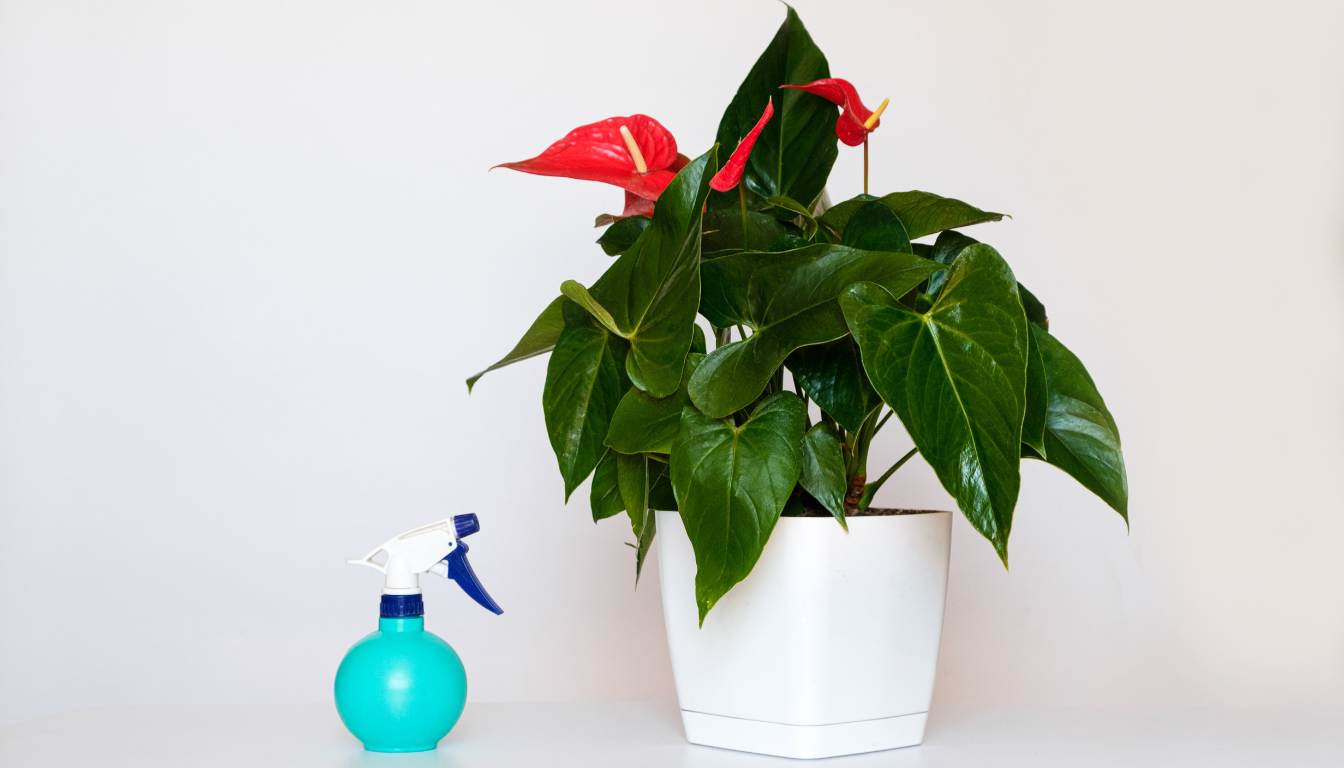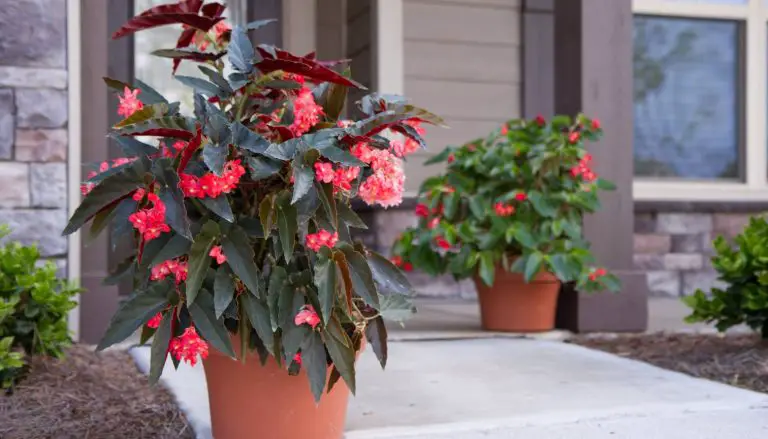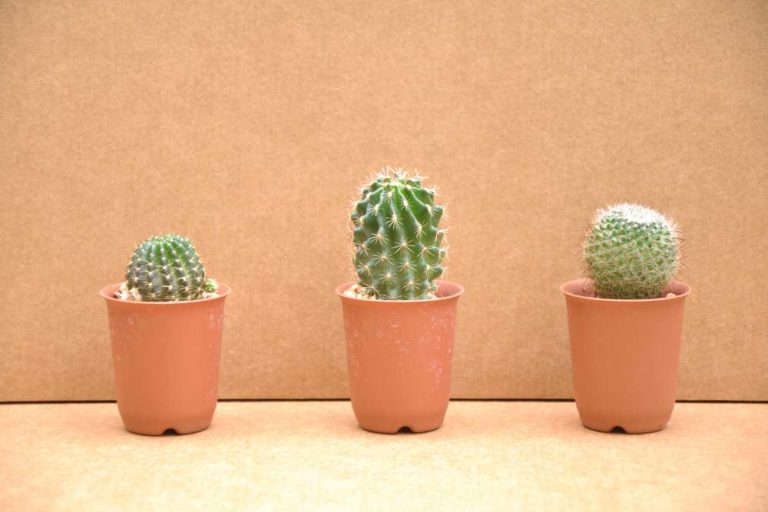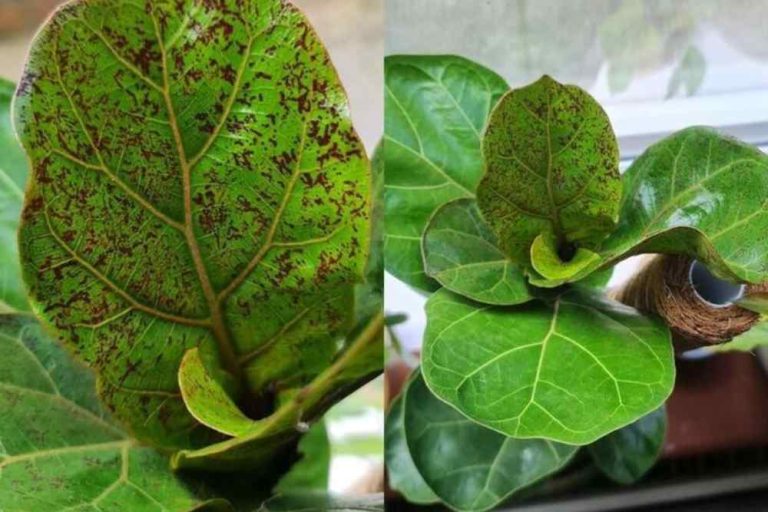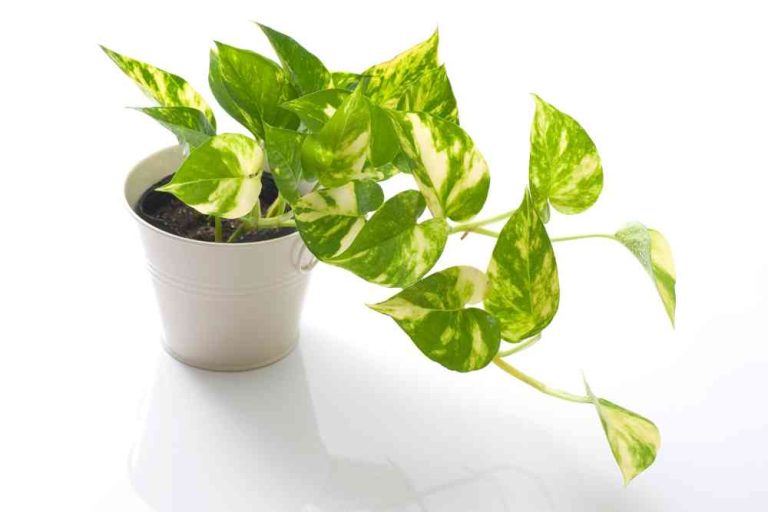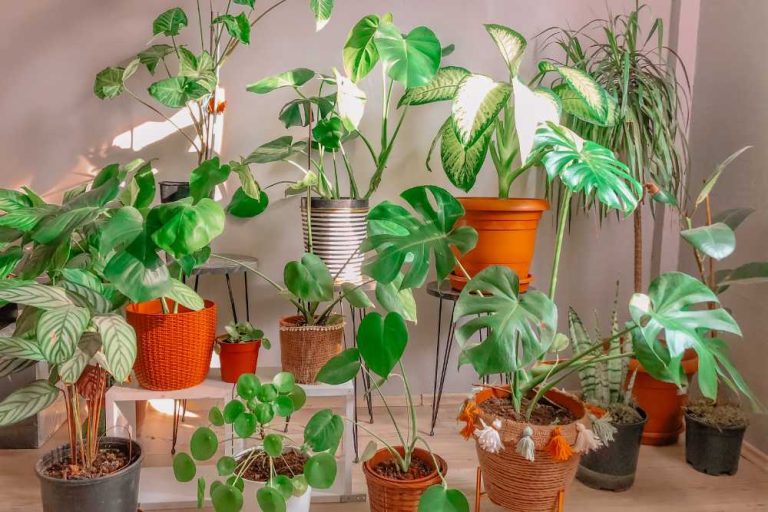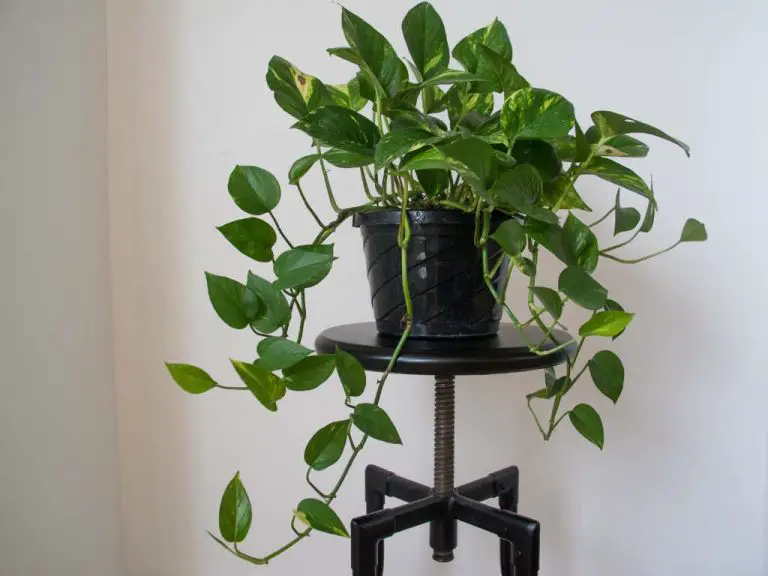Anthurium Houseplant Care Guide for Vibrant Growth
Welcome to our comprehensive guide on anthurium houseplant care! Whether you’re a beginner or an experienced plant enthusiast, this guide will provide you with expert tips and advice to help your anthurium plants thrive and display stunning colors. From watering to sunlight requirements, soil selection, fertilization, pruning, and pest control, we’ve got you covered. Let’s dive in!
Key Takeaways:
Understanding Anthurium Plants
Before diving into the details of anthurium houseplant care, let’s take a moment to understand this stunning plant. Anthurium plants are native to tropical regions and are admired for their glossy, heart-shaped leaves and vibrant flowers. These plants thrive in warm and humid environments, making them a popular choice for both indoor and outdoor cultivation.
Now, let’s explore some essential care tips to ensure the health and well-being of your anthurium plant. By following these guidelines, you can enjoy the beauty of your anthurium and witness its vibrant growth.
Watering Anthurium Plants
Proper watering is crucial for the growth and vitality of anthurium plants. These tropical beauties require a delicate balance of moisture to thrive. In this section, we will discuss the watering requirements of anthurium plants, including the frequency, amount, and techniques to prevent overwatering or underwatering.
Understanding the Watering Needs
Anthurium plants prefer consistently moist but not soggy soil. It’s important to water them thoroughly, allowing the excess water to drain away. Once the top inch of soil feels slightly dry to the touch, it’s time to water again.
Watering Techniques
When watering your anthurium plant, pour water directly into the soil around the base of the plant, avoiding wetting the foliage. This helps prevent diseases caused by excess moisture on the leaves. Ensure that the water reaches the root zone by watering until it starts to seep through the drainage holes of the pot.
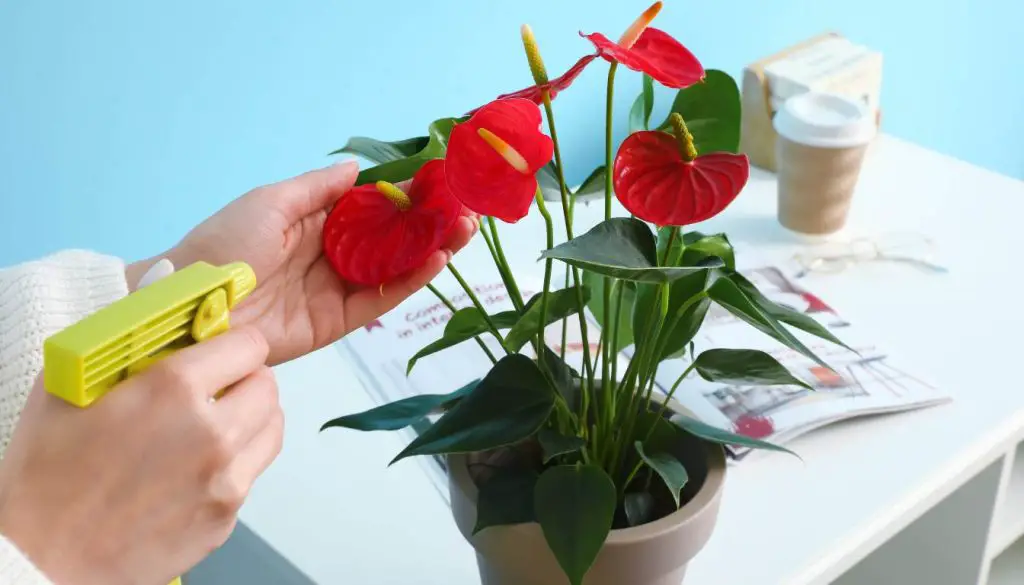
Preventing Underwatering and Overwatering
Underwatering anthurium plants can lead to wilting, yellowing leaves, and stunted growth. On the other hand, overwatering can cause root rot and fungal diseases. By understanding the specific needs of your anthurium plant, you can maintain the ideal moisture levels and promote healthy root development.
Monitoring the moisture level of the soil and adjusting your watering frequency accordingly is key. Factors like temperature, humidity, and pot size can affect how quickly the soil dries out. During hotter months or in drier climates, you may need to water more frequently, while reducing watering during cooler periods or when the plant is dormant.
Remember, it’s better to slightly underwater than overwater your anthurium plant. Signs of overwatering include yellowing leaves, root rot, and a foul smell from the soil. If you notice these symptoms, adjust your watering routine accordingly and consider improving drainage by repotting in a well-draining soil mix.
Read – 9 DIY Automatic Watering System for Indoor Plants
Providing Adequate Sunlight
Sunlight plays a vital role in the care of anthurium plants. These tropical beauties thrive in bright, indirect light, which is essential for optimal growth and vibrant flowering. Understanding the sunlight requirements of your anthurium plant is crucial to ensure its well-being and beauty.
Anthurium plants require bright, filtered sunlight. Placing your plant near a north or east-facing window is ideal as it provides bright, indirect light without exposing the plant to intense afternoon sun. If you have a south or west-facing window, consider using sheer curtains or blinds to filter the sunlight and prevent direct exposure.
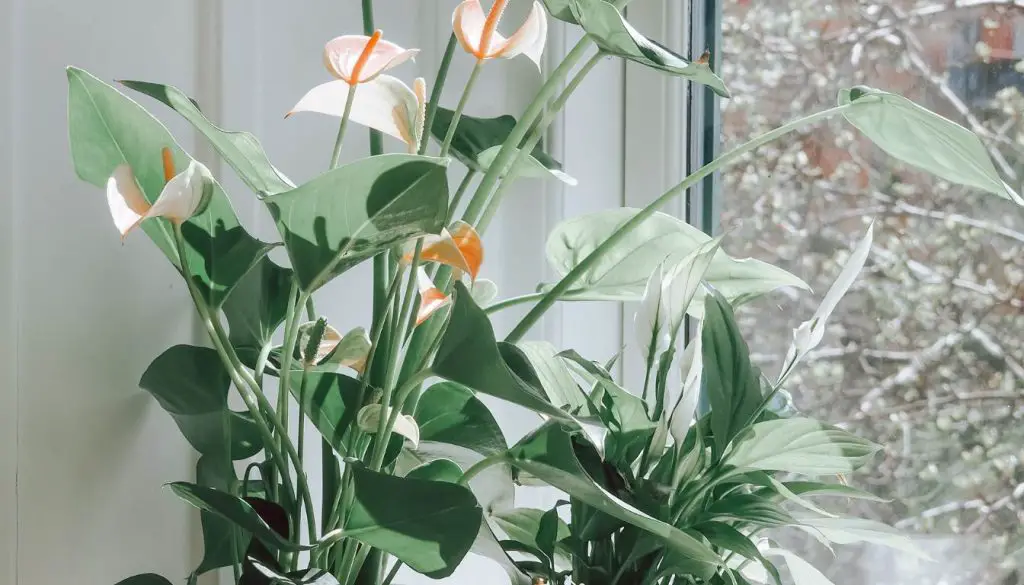
In cases where natural light is limited, you can supplement it with artificial lighting. LED grow lights are a popular choice, as they provide the necessary spectrum and intensity of light for anthurium plants. Position the lights approximately 12 inches above the plant and maintain a light schedule of 12-14 hours a day to mimic natural daylight conditions.
It’s important to note that excessive or inadequate exposure to sunlight can negatively impact anthurium plants. Too much direct sunlight can scorch the leaves and cause them to turn yellow or brown. On the other hand, insufficient light can result in weak growth, leaf discoloration, and a lack of flowering.
Observing your plant’s response to sunlight is crucial in determining whether adjustments are needed. If the leaves start to show signs of sunburn, such as browning or yellowing, it’s a clear indication that the plant is receiving too much direct light. Conversely, if the leaves appear pale or elongated, it may be a sign that the plant is not getting enough light.
Choosing the Right Soil
The success of anthurium plants heavily relies on the choice of soil. The ideal soil composition, pH levels, and drainage requirements play a vital role in their overall health and well-being.
By understanding the importance of good soil, you can provide your anthurium plants with the necessary nutrients and a well-aerated environment for robust growth.
Fertilizing Anthurium Plants
Fertilization is an essential aspect of anthurium houseplant care, providing the necessary nutrients for healthy growth and vibrant blooms. By understanding the right type of fertilizer, application techniques, and frequency, you can ensure your anthurium plant receives the optimum nutrition it needs.
When it comes to fertilizing anthurium plants, a balanced, water-soluble fertilizer with a ratio of 10-10-10 or 20-20-20 is ideal. This will provide a balanced combination of nitrogen (N), phosphorus (P), and potassium (K) – the essential macronutrients for plant growth.
Application techniques:
Foliar Feeding:
One method of fertilizing anthurium plants is through foliar feeding, which involves spraying the fertilizer solution directly onto the leaves. Dilute the fertilizer according to the package instructions and mist the foliage thoroughly, ensuring complete coverage.
This method allows the plant to absorb nutrients directly through the leaves and is particularly useful for addressing nutrient deficiencies.
Root Drench:
Another method is root drenching, where the fertilizer solution is applied directly to the soil surrounding the plant’s root system. Dilute the fertilizer as instructed, then pour the solution onto the soil, taking care not to saturate it. This allows the roots to absorb the nutrients as they naturally take up water.
Frequency:
For most anthurium plants, fertilize every two to four weeks during the active growing season, which is typically spring and summer. During the dormant period in fall and winter, reduce fertilization to once every two months. Adjust the frequency based on the specific fertilizer brand and the plant’s individual needs.
Remember to always follow the instructions provided with your chosen fertilizer, as different brands may have specific guidelines for anthurium plants.
With proper fertilization, your anthurium plant will receive the necessary nutrients to thrive, resulting in healthy foliage and stunning blooms. Combine fertilization with other essential care practices, such as proper watering and suitable sunlight exposure, to ensure your anthurium plant flourishes.
Pruning and Maintenance
Pruning is a vital part of anthurium plant care that promotes healthy growth, maintains its shape, and eliminates diseased or damaged parts. By regularly pruning your anthurium plant, you can encourage new growth and ensure it stays aesthetically pleasing.
When it comes to pruning anthurium plants, it’s important to have the right tools on hand. Use sterilized pruning shears to make clean cuts without spreading diseases. Make sure to disinfect the tools before and after each use to prevent the spread of any potential pathogens.
Knowing when to prune is equally crucial. The best time to prune anthurium plants is in early spring or late winter, just before new growth emerges. Look for any dead or yellowing leaves, overcrowded stems, or branches that are crossing each other.
Read – Indoor Plant Cuttings: A Complete Guide
Pruning Techniques for Anthurium Plants
When pruning your anthurium plant, follow these techniques:
- Trim the dead or dying leaves at the base of the stem. These can rob nutrients from healthy parts of the plant.
- Remove any yellowing or discolored leaves as they are usually a sign of an underlying issue.
- Thin out crowded stems by cutting them at the base, allowing air and light to reach the remaining foliage.
- Trim branches that are crossing or rubbing against each other to prevent damage and create a more open structure.
- Trim any flowers or dead flower spikes to encourage the growth of new blooms.
After pruning, take the opportunity to inspect your anthurium plant for any signs of pests or diseases. This way, you can address any issues promptly and prevent them from spreading.
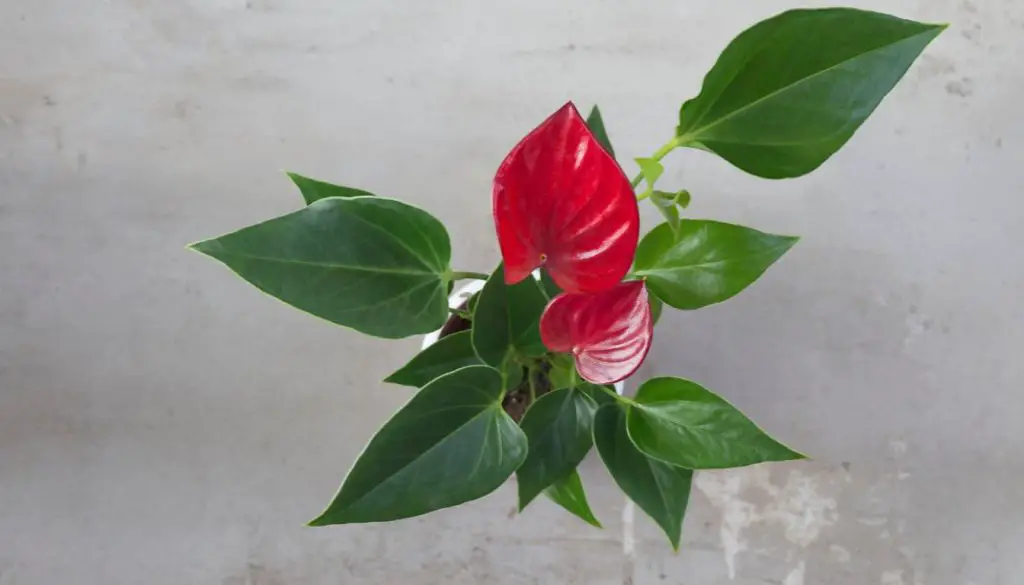
General Maintenance Tips
In addition to pruning, here are some general maintenance tips to keep your anthurium plant in top shape:
- Regularly dust the leaves with a soft cloth or use a gentle spray of water to keep them clean and free from dust and debris. This enhances the plant’s ability to absorb light.
- Monitor the soil moisture and water your anthurium plant as needed, ensuring it doesn’t sit in waterlogged conditions.
- Rotate your plant periodically to ensure even growth and prevent it from leaning toward the light source.
- Inspect the leaves and stems for any signs of pests or diseases, such as mites or leaf spots. Treat them promptly using appropriate organic or chemical solutions.
Dealing with Pests and Diseases
Anthurium plants, like any other plant, are susceptible to pests and diseases that can hinder their growth and overall health. In this section, we will explore the common pests that can affect anthurium plants and provide you with effective prevention methods and treatment options to keep your plant thriving.
Identifying Common Pests
Understanding the pests that can attack your anthurium plants is crucial in preventing and addressing infestations. Common pests that may target anthuriums include:
- Aphids: These small, soft-bodied insects feed on the sap of plant tissues, causing leaves to curl and distort.
- Mealybugs: Mealybugs are tiny, oval-shaped insects covered in a white, waxy substance. They can weaken anthurium plants by sucking out their juices.
- Spider Mites: These tiny pests are too small to be seen without magnification, but their presence can be detected by the fine webbing they produce on plant leaves.
- Thrips: These slender insects feed on anthurium leaves, causing them to develop a silvery appearance and eventually yellow or brown spots.
Prevention and Treatment
To safeguard your anthurium plant from pests and diseases, it is essential to implement preventive measures and address any infestations promptly. Here are some tips:
- Inspect regularly: Regularly examine your plant for signs of pests, such as yellowing or distorted leaves, tiny insects, or webbing. Early detection can prevent further damage.
- Isolate infected plants: If you notice any signs of infection, separate the affected anthurium plant from others to prevent the pests or diseases from spreading.
- Natural remedies: For minor infestations, consider using natural remedies like neem oil or insecticidal soaps. These products can help control pests while being gentler on the plants and the environment.
- Chemical treatments: In severe cases, chemical pesticides may be necessary. However, always follow the instructions carefully to avoid damaging the plant and ensure the safety of pets or children.
- Maintain cleanliness: Keep the area around your anthurium plant clean and free from fallen leaves or debris, as these can harbor pests and diseases.
Propagating Anthurium Plants
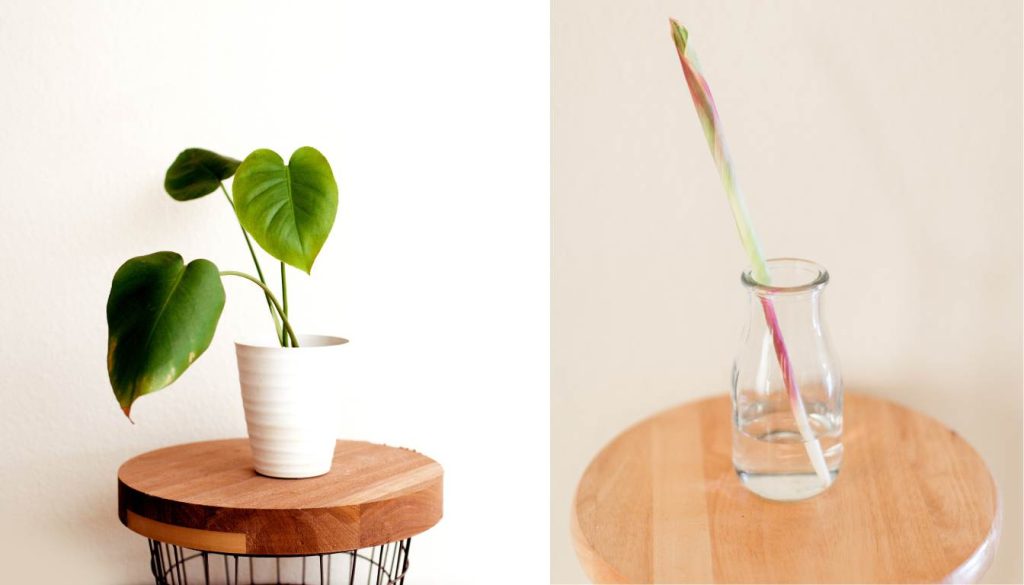
Propagating anthurium plants is a wonderful way to expand your plant collection or share this stunning species with others. In this section, we will explore the various methods of propagating anthurium plants, including division, stem cuttings, and seed germination. By following our step-by-step instructions, you can successfully propagate your anthurium plants and cultivate a thriving collection.
Division
One effective method of propagating anthurium plants is through division. Start by removing the parent plant from its pot and gently separating the root ball into smaller sections. Each section should have its own healthy roots and several leaves.
Plant each divided section in a separate pot, ensuring the soil is well-drained and rich in nutrients. Water thoroughly and provide the appropriate care to encourage new growth.
Stem Cuttings
Another popular way to propagate anthurium plants is through stem cuttings. Select a healthy, mature stem and use a clean, sharp knife or pruning shears to cut a portion that includes at least two nodes. Remove the lower leaves, leaving only a few near the top.
Dip the cut end in a rooting hormone to promote root growth, then plant the cutting in a well-draining potting mix. Mist the cutting regularly and place it in a warm, bright area with indirect sunlight. With time and care, your cutting will develop roots and grow into a new anthurium plant.
Read – Asexual Propagation of Plants
Seed Germination
For those who enjoy starting plants from scratch, propagating anthurium plants from seeds can be a rewarding endeavor. Collect mature seeds from a healthy anthurium plant and sow them in a seed tray or pots filled with a well-draining mixture.
Keep the soil moist and maintain a warm and humid environment to encourage germination. With consistent care and patience, the seeds will sprout, and you can transplant the seedlings into individual pots once they develop sturdy roots and leaves.
Remember to provide adequate water, sunlight, and care to your propagated anthurium plants, just as you would for mature plants. With proper propagation techniques and dedicated care, you can expand your anthurium collection and enjoy the beauty of these remarkable plants.
Summary and Care Recap
Throughout this article, we have covered the essential aspects of anthurium plant care to ensure your plant thrives with vibrant growth and stunning colors. By understanding and implementing proper care techniques, you can create an ideal environment for your anthurium plant.
- First and foremost, watering is crucial for the health of your anthurium plant. Avoid overwatering or underwatering by providing just the right amount of water, ensuring the soil stays evenly moist but not waterlogged.
- Sunlight is another vital factor in anthurium plant care. Place your plant in a location that receives bright, indirect light or provide artificial lighting to meet its sun exposure needs. This will help maintain its lush foliage and encourage blooming.
- Choosing the right soil for your anthurium plant is essential. Opt for well-draining soil that is rich in organic matter and has a slightly acidic pH level. This will ensure proper nutrient absorption and prevent waterlogged conditions.
- In terms of fertilization, use a balanced, water-soluble fertilizer formulated specifically for flowering plants. Apply it according to the package instructions to provide your anthurium plant with the necessary nutrients for robust growth and vibrant blooms.
- Regular pruning is crucial for maintaining the shape and appearance of your anthurium plant. Remove any yellowing or damaged leaves, as well as faded blooms, to encourage new growth and maintain the plant’s overall health and beauty.
- Lastly, be proactive in preventing and managing pests and diseases that can affect your anthurium plant. Regularly inspect your plant for signs of infestation or disease, and take appropriate measures to control and treat them promptly.
FAQ
Can I grow anthurium plants indoors?
Yes, anthurium plants can thrive indoors if provided with the right conditions. They require bright, indirect sunlight and a warm and humid environment. Avoid placing them in direct sunlight as it can scorch their leaves. Additionally, ensure proper ventilation to prevent the buildup of excess moisture.
How often should I water my anthurium plant?
Anthurium plants prefer consistently moist but not waterlogged soil. Water them when the top inch of soil feels slightly dry to the touch. It’s better to underwater than overwater, as excessive moisture can lead to root rot. Drain any excess water from the saucer or tray to prevent the plant from sitting in standing water.
What type of soil is best for anthurium plants?
Anthurium plants thrive in well-draining soil that retains some moisture. A recommended mix is equal parts peat moss, perlite, and orchid bark. This blend allows for proper aeration, drainage, and moisture retention. Avoid using heavy or clay-based soils that can cause waterlogging.
How often should I fertilize my anthurium plant?
Fertilization is essential to provide anthurium plants with the necessary nutrients for healthy growth and vibrant blooms. During the growing season, which is typically spring and summer, fertilize your plant every 4-6 weeks using a balanced liquid fertilizer diluted to half strength. Reduce or stop fertilization during the winter months when the plant is in its dormant phase.
Do anthurium plants require pruning?
Yes, pruning is beneficial for anthurium plants to maintain their shape and promote new growth. Remove any dead, damaged, or diseased leaves or flowers by cutting them off at the base. Use clean and sharp pruning shears to minimize damage. Pruning can also help control the size of your plant and prevent overcrowding.
How do I propagate anthurium plants?
Anthurium plants can be propagated through division, stem cuttings, or seed germination. Division involves separating the plant into smaller sections, ensuring each has sufficient roots and stems. Stem cuttings can be taken from healthy plants and rooted in a well-draining medium. Seed germination requires collecting mature seeds, planting them in a suitable medium, and providing the right conditions for growth.
What are common pests and diseases that affect anthurium plants?
Anthurium plants can be susceptible to pests such as aphids, mealybugs, spider mites, and scale insects. Diseases like root rot and bacterial leaf spot can also occur. To prevent and treat these issues, regularly inspect your plants for signs of infestation or disease, maintain proper hygiene, and use organic or chemical treatments as needed.
- 18 Creative Ideas for Stunning Garden Borders - April 16, 2024
- 19 Creative and Cheap Backyard Ideas: Transform Your Backyard on a Budget - April 11, 2024
- 15 Ingenious Kitchen Garden Ideas to Cultivate Freshness Right at Home - April 7, 2024

